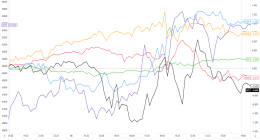
In quantum mechanics, a particular property of a substance—electrical conductivity, say, or optical transparency or reflectivity—corresponds to the average or “expectation value” of an observable quantity. If you have the wave function of a substance and you know what kind of light pulse you’re using, you can predict the result—the expectation value—you’re going to get.
Bondar’s team inverts the problem: You start with the outcome you want to achieve (the expectation value) and calculate the light pulse that will produce it. To do that, you also need to know the system’s wave function, or equivalently its Hamiltonian—which in general you don’t. But that’s OK, so long as you can identify a good enough approximation: a kind of “toy” wave function that comes close enough to capturing the important features of the real one.
In this way, the researchers figured out how to extend the methods from small collections of molecules, where there are just a handful of electrons to control, to large, bulky solids with a whole sea of electrons. “We look at the system as a cloud of electrons, and we start deforming the cloud,” said Bondar. The control pulse creates a kind of track that the electrons must follow, so the approach is called tracking control.
Christian Arenz, a theoretical chemist in Rabitz’s group at Princeton who is collaborating with Bondar’s team, explained that this approach makes it much easier to find the right control field for manipulating a substance’s properties. Previously, designing the control field was a matter of gradual, iterative improvement, but the tracking approach establishes “a new avenue for controlling many-body systems,” Arenz said. “I believe that this work will greatly inspire future control methods.”
To Reshape a Solid
Much of the early work on quantum coherent control focused (literally) on inducing well-defined changes in individual molecules—for example, selectively pumping energy into a given chemical bond to make it vibrate to breaking point, and perhaps thereby controlling the course of a chemical reaction. But manipulating many electrons coherently all at once in a material is a tougher challenge.
When atoms come together in solids, the outermost electron shells of neighbors overlap and form “bands” that extend throughout the material. The electronic and optical properties depend on the features of these bands. In metals, for example, the electrons with the highest energies occupy a band that is not filled to capacity, so the electrons can move throughout the atomic lattice, allowing the material to conduct electricity. In an insulating material, meanwhile, the highest-energy band occupied by electrons is entirely filled, so there are no “spaces” for these electrons to move into. They remain localized on their atoms, and the material won’t conduct.
More exotic types of electronic behavior can arise from quantum mechanical effects that make the electrons’ movements interdependent (that is, correlated), like the movement of groups of people in a crowd. In conventional superconductors, for example, the highest-energy electrons form correlated pairs (called Cooper pairs) that move in synchrony even though the two electrons might be some distance apart—like a person chasing another through a crowd. These Cooper pairs all behave identically, giving them an unstoppable momentum that enables a superconductor to conduct electricity without any resistance. It’s as if the electrons no longer notice the underlying lattice of atomic nuclei.
But what kinds of materials give rise to such properties? Usually in order to find them you need to go fishing in the sea of permutations of different elements. That’s very slow and labor-intensive—witness the huge amount of time and effort spent on developing new superconducting materials.
Imagine, though, that it’s possible to invoke a desired property in more or less any material by using light pulses to reshape the way the electrons are distributed. In this view, electron band structure is not something fixed by the material itself: The bands instead become a kind of putty that can be molded into whatever form you desire. Find the right control pulse and you might be able to join an array of mobile electrons into Cooper pairs, say, and thereby make a superconductor, perhaps from some humble substance such as iron or copper, under conditions in which it would otherwise be impossible.
This notion of using shaped laser pulses to specify and control the properties of materials has already borne fruit. For example, researchers have used it to switch materials between insulating and metallic behavior, to control magnetic properties, and to trigger superconductivity. The general idea is that the light pulses redistribute electrons among the energy bands in a way that tips the balance between one phase of the system and another—between a metal and an insulator, say. In this way, researchers have produced superconductivity at temperatures tens of degrees above the frigid extremes usually needed.








